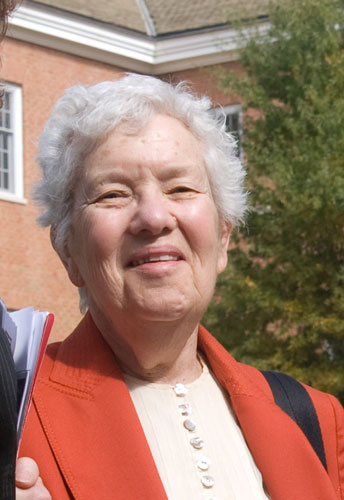American astronomer Vera Rubin (1928–2016) measured how fast galaxies rotate, delivering decisive evidence for the existence of dark matter.

Since Vera Rubin (née Cooper) was a child, she had a passion for astronomy. At age 10, she would watch the night sky revolve from her north-facing bedroom window in Washington D.C. Her parents were particularly encouraging of her interests, having helped her build a telescope and taking her to amateur astronomer meetings. Even though she received little encouragement from her high school physics teacher and college admissions officers, Rubin pursued a career in astronomy.
Rubin received a scholarship to attend Vassar College in Poughkeepsie, New York — following in the footsteps of her childhood hero, astronomer Maria Mitchell. By 1951 she had completed a Master’s degree in astronomy at Cornell University. For her master’s thesis, she observed the motions of galaxies and argued that rather than expanding, as the Big Bang theory would suggest, they might actually be rotating around unknown centers.
These ideas were not well-received. Nevertheless, her master’s work caught the attention of physicist George Gamow at Georgetown University, where she went on to complete her graduate work. Her 1954 PhD thesis concluded that galaxies clumped together rather than being randomly distributed through the universe, observations and analysis that the scientific community couldn’t do until the 1970s with better technology.
From 1955 to 1965, Rubin worked at Georgetown as research associate, and then as assistant professor. She worked on galaxy rotation with Geoffrey and Margaret Burbidge from 1963 to 1964 before she joined the Carnegie Institution of Washington Department Terrestrial Magnetism in 1965. In the following years, she took multiple observing trips with collaborator Kent Ford. While they initially studied quasars, the pair decided to turn his spectrograph onto nebulae in the Andromeda Galaxy.
In 1965 Rubin’s previous research experience allowed her to become the first woman invited to legally use the Palomar Observatory in southern California. Previously, women’s observing proposals were declined — mainly because of the male-only living quarters (which were humorously called the monastery) and the single toilet.
In the early 1970s, Rubin renewed her interest in the motion of stars within galaxies, this time homing in on the Andromeda Galaxy in collaboration with Ford. Astronomers assumed that most of a galaxy’s mass, and hence gravity, was concentrated in its core region, where we see the highest concentration of stars. Just as Saturn circles the Sun more slowly than fleet-footed Mercury, a star farther from the center of a galaxy should also orbit at a slower speed.
Yet when Rubin observed rotation rates in the Andromeda Galaxy, she found something surprising. As expected, the stars closer to the center of the bulge of the galaxy orbited faster than the stars near the edge of the bulge. But stars far outside the bulge orbited at the same rate as the stars just within the bulge —even though there wasn’t enough visible mass to hold them in their orbits.
Rubin realized there had to be a large amount of unseen matter in the outer regions of the galaxies. After publishing the Andromeda results in the Astrophysical Journal, she went on to find similar results for another 60 galaxies, concluding that galaxies must generally contain about ten times more “dark” mass than stars, gas, and other visible matter.
“In a spiral galaxy, the ration of dark-to-light matter is about a factor of ten. That’s probably a good number for the ration of our ignorance-to-knowledge. We’re out of kindergarten, but only about in third grade,” Rubin said in her book Bright Galaxies, Dark Matters.
Rubin’s scientific achievements have earned her numerous awards and honors, including being the second woman astronomer to be elected to the National Academy of Sciences. In addition to continuing her research, Rubin encourages young girls to pursue their dreams of investigating the universe. Motivated by her own battle to gain credibility, she considers it a responsibility and privilege to be a mentor.
She is married to Robert Rubin and together they have four children: David, Judith, Karl, and Allan — all of whom have PhDs in the sciences.
References:
- https://apps.carleton.edu/campus/observatory/research/cindystudents/1998mn/history/mtwilson/
- http://www.amnh.org/explore/resource-collections/cosmic-horizons/profile-vera-rubin-and-dark-matter/
- http://jwa.org/encyclopedia/article/rubin-vera-cooper
Paper:
 0
0








Comments
You must be logged in to post a comment.